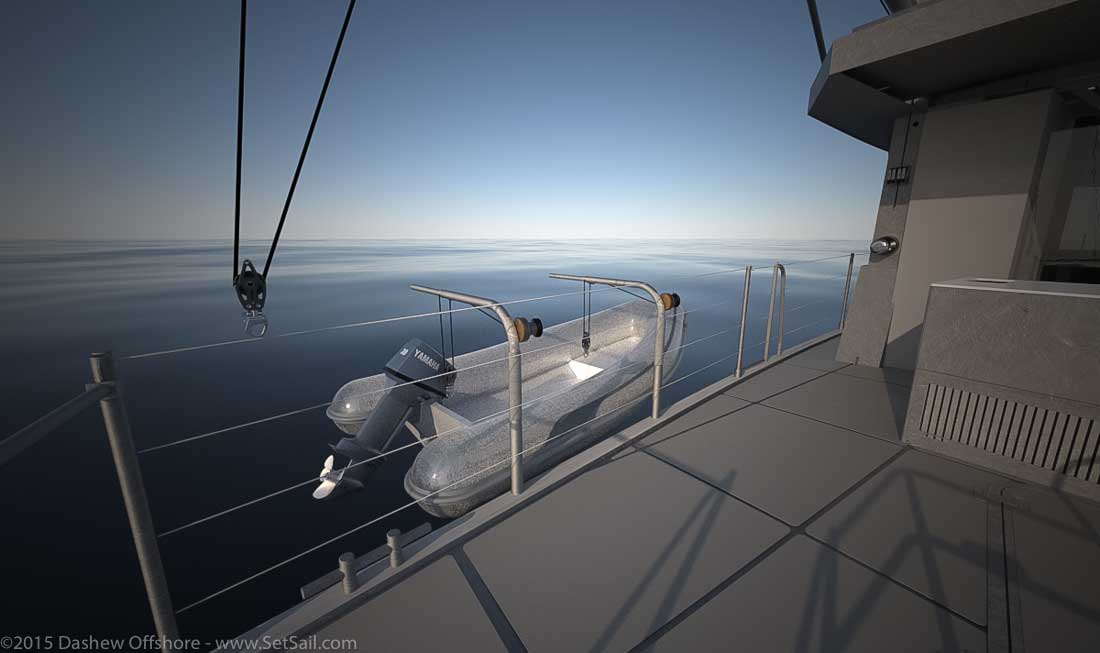![IFPB-78-1-Aft-Deck-Final-2.jpg]()
The aft end of the FPB 78 has gone through a design evolution, a benefit of the 3D design process and working with two very experienced owners.
We’ll do a post on that process at a later time. For now, let us bring you up to date first with FPB 78-1, and then with how FPB 78-2 and 78-3 are being done. We now carry a 16-foot AB RIB, and a second, smaller dink. Shown above is a 14’ wherry.
![FPB-78-1-Aft-Deck-Final-9]()
There is room for a ten or 11’ RIB, if one prefers two inflatables.
![FPB-78-1-Aft-Deck-Final]()
The cassettes on the swim platform store the large flopper stoppers. This makes them much easier to set and retrieve. The flammable stores locker is to starboard and can carry 14 twenty-liter containers. The large port side locker is where we will put dock lines, hoses, shore power cord, deflated fenders, garbage, and other items that need to be handy. The stern anchor/kedge stores between the stairs and flopper stopper, where it is out of the way but easy to deploy.
The aft deck winch, a powered Lewmar 65, will be used for docking, kedging, and dinghy handling on the port side. A small but important detail is that the line coming out of the self-tailer will flake on the swim platform where it is out of the way.
![FPB-78-1-Aft-Deck-Final-8]()
The engine room air intake provides a base onto which a variety of creations can be attached. The first three FPB 78s have this as a barbecue area, with adjacent work surface, sink, and storage underneath.
The port dinghy will be stored high, with space below for those all-important water tools, like paddle boards, kayaks, etc.
![FPB-78-1-Aft-Deck-Final-10]()
Those support arms rotate out of the way when the dinghy is launched, opening up the deck area. They also rotate outboard, providing a storage location for the dinghy that is usable when local cruising.
![FPB-78-1-Aft-Deck-Final-11]()
They are usable for lifting the dinghy or kayak out of the water.
![FPB-78-1-Aft-Deck-Final-7]()
FPB 78-2 and 78-3 have a different swim platform layout. They are trading the access to the aft interior of FPB 78-1 for more storage volume aft. The area from the flammable stores locker across the boat is all storage. The interior walls are designed so they can easily add or change shelves, racks, etc. with a simple bolt-on system. Access to these lockers is via sliding doors.
![porch-enclosure-set.jpg Porch enclosure set]()
Let’s take a closer look now at the aft end of the house. There are storage lockers port and starboard. The starboard locker serves as a conduit for plumbing and wiring to and from the interior, engine room, and Matrix deck. There is a Lewmar reel halyard winch for hoisting the big dinghy. Space is left for hanging coats, boots and the storage of gear. The BBQ cabinet has been unbolted here and the top of the engine room air intake converted to a seat.
![porch-enclosure-set-2.jpg Porch enclosure set 2]()
The port side locker has the fridge and freezer compressors inside, a pair of Delta T 11” (1400 CFM) extraction fans which pull from the great room, as well as more storage space. Note the clear plastic enclosure panel. This will be deployed when we want to control the environment of the Matrix deck.
![porch-enclosure-set-3.jpg Porch enclosure set 3]()
The structure at the aft end of the starboard mast is part of the engine room ventilation system. The inlet pipe is above the 70 degree heel flood line. The top is designed as a tray, handy for all sorts of things.
The bank of rope clutches are for the boom control lines, flopper stopper halyard, and extra halyard. The Lewmar #50 winch will help with boom movement and be handy with dock line adjustment.
























































































































































